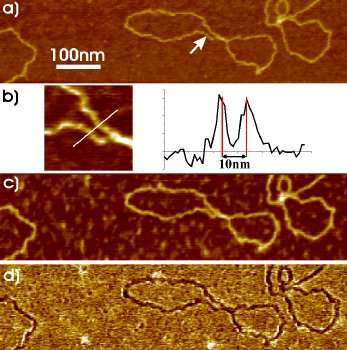JPK Instruments, a world-leading manufacturer of nanoanalytic instrumentation for research in life sciences and soft matter, reports on a keynote paper in Nano Letters where Dr Nikolai Severin and his co-workers from the group of Professor Jürgen P. Rabe have applied JPK's NanoWizard®II Ultra system to improve their understanding of the properties of graphene.
 Images taken on a 6 day old sample in the area of a single graphene: (a) Topography image recorded in contact mode under a normal force of 25 nN. Arrow indicates an area enlarged on (b) with two resolved DNA strands running nearly parallel to each other at a distance of 10 nm, as visualized by the inserted cross section. (c) Intermittent contact mode topography image acquired a few minutes after (a) with the same tip. (d) Intermittent contact mode phase contrast image of the same area.*
Images taken on a 6 day old sample in the area of a single graphene: (a) Topography image recorded in contact mode under a normal force of 25 nN. Arrow indicates an area enlarged on (b) with two resolved DNA strands running nearly parallel to each other at a distance of 10 nm, as visualized by the inserted cross section. (c) Intermittent contact mode topography image acquired a few minutes after (a) with the same tip. (d) Intermittent contact mode phase contrast image of the same area.*
The Physics of Macromolecules group of Professor Jürgen P. Rabe has a central research goal to correlate structure and dynamics of molecular systems at interfaces with mechanical, electronic, optical and (bio-)chemical properties from molecular to macroscopic length and time scales. Manipulation and imaging of single molecules and supramolecular systems with a scanning force microscope (SFM) is of paramount importance to the understanding of structure formation and the measurement of mechanical properties. The group is also involved in understanding and developing molecular electronics and organic electronic properties.
Within this group is Dr Nikolai Severin, recently the lead author of a paper in Nano Letters* which shows the use of AFM in the study of graphenes. The electronic properties of graphenes depend sensitively on their deformation, and therefore strain-engineered graphene electronics is envisioned. In order to deform graphenes locally, the group has mechanically exfoliated single and few layer graphenes onto atomically flat mica surfaces covered with isolated double stranded plasmid DNA rings. Using scanning force microscopy in both contact and intermittent contact modes, they have found that the graphenes replicate the topography of the underlying DNA with high precision. The availability of macromolecules of different topologies, e.g., programmable DNA patterns render this approach promising for new graphene based device designs. Furthermore, the encapsulation of single macromolecules offers new prospects for analytical scanning probe microscopy techniques.
Dr Severin has seen that graphene provides enhanced protection of DNA molecules to shear forces exerted during scanning force microscopy in contact mode. In addition, graphene will act as a surface protective layer against the ambient, e.g., against oxidation, since it is impermeable to gases. Taking into account both the high electric conductivity of graphene and its extremely small thickness, this offers new opportunities for scanning probe microscopies and spectroscopies, such as scanning tunneling or tip enhanced Raman spectroscopy for analyses of both locally deformed graphene and confined molecules. Summarising, Dr Severin said, "We have successfully demonstrated that topography of graphenes can be controlled with the precision down to single molecules, i.e. graphenes are so flexible that they can replicate the topography of single molecules, when deposited on these molecules."
He also commented on some of the reasons for choosing to work with JPK NanoWizard® II for this work: "We are able to use a relatively large size of samples and scan areas of up to 30 microns. The linearized scanner is most important for us to precisely measure the height of DNA and their cross sections. The system shows little thermal drift which is important when making measurements on such small length scales. I also found the software was quite easy to use."
* Reference acknowledgment:
Replication of Single Macromolecules with Graphene, N . Severin*†, M. Dorn†, A. Kalachev‡, and J. P. Rabe*†;†Department of Physics, Humboldt-Universitaat zu Berlin, Newtonstrasse 15, 12489 Berlin, Germany. ‡ PlasmaChem GmbH, Rudower Chaussee 29, 12489 Berlin, Germany: Nano Lett., 2011, 11 (6), pp 2436–2439; DOI: 10.1021/nl200846f; Publication Date (Web): May 16, 2011; Copyright © 2011 American Chemical Society